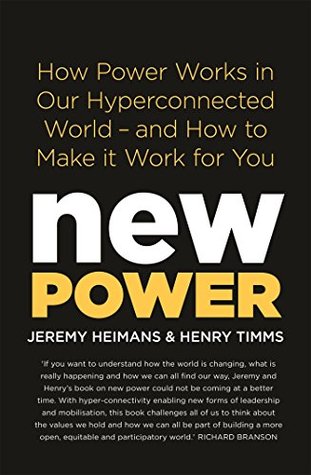More on this book
Community
Kindle Notes & Highlights
Old power works like a currency. It is held by few. Once gained, it is jealously guarded, and the powerful have a substantial store of it to spend. It is closed, inaccessible, and leader-driven. It downloads, and it captures. New power operates differently, like a current. It is made by many. It is open, participatory, and peer-driven. It uploads, and it distributes. Like water or electricity, it’s most forceful when it surges. The goal with new power is not to hoard it but to channel it.
New power models work more like Minecraft,
Instead of a model built on top-down compliance, it is a game built from the bottom-up, with players around the world co-creating worlds together, block by block. It relies entirely on participatory energy.
The players set their rules and create their own tasks. There is no “manual”; players learn from the example—and often the homemade videos—of others. Some players (known as “modders”) are even entrusted with the capacity to alter the game itself.
The future will be a battle over mobilization. The everyday people, leaders, and organizations who flourish will be those best able to channel the participatory energy of those around them—for the good, for the bad, and for the trivial.
Trump
Think of him as a Platform Strongman, mastering new power techniques to achieve authoritarian ends.
The more we engage with new power models, the more these norms are shifting. Indeed, what is emerging—most visibly among people under thirty (now more than half the world’s population)—is a new expectation: an inalienable right to participate.
New power models, at their best, reinforce the human instinct to cooperate (rather than compete) by rewarding those who share their own assets or ideas, spread those of others, or build on existing ideas to make them better.
To many young people, this pragmatic rationale for lack of transparency or straightforwardness just isn’t acceptable anymore. In an era in which young people are sharing the most intimate details of their lives on social media, it shouldn’t be surprising that in the workplace they are now demanding that their bosses share information previously considered strictly confidential, like company-wide salary information.
ethos of radical transparency.
The big clash here is between the “need to know” mindset, which instinctively keeps information away from the public for its own protection, and a rising “right to know” expectation, where new power thinkers demand openness from institutions as a default.
Glorifying being a “creator” rather than just a passive consumer, and best of all a hybrid—a coder-designer-engineer-doctor-musician-vet—is a big theme in new power culture.
We can think of maker culture as the “do-it-ourselves” mindset
Makers are less dependent on institutions. They figure out how to avoid the intermediaries.
In fact, over the last decade, the Edelman Trust Barometer has measured significantly increasing trust in “people like me,” which has reached higher levels than public trust in academic experts or doctors.
“We don’t really care about doing things well, we just care about doing them together.”
But the rise of new power is asking us to consider some new principles, too.
We may understand how to “make it stick,” but in a world of manic participation, awash in information, how do we “make it spread”?
When people are no longer satisfied with simply consuming ideas, but increasingly expect to play a role in developing, tweaking, and propagating those ideas to an unlimited potential audience, w...
This highlight has been truncated due to consecutive passage length restrictions.
successful ideas and communications strategies today add ACE to SUCCESS. ACE stands for the three design principles key to making an idea spread in a new power world:
Actionable—The idea is designed to make you do something—something more than just admire, remember, and consume. It has a call to action at its heart, beginning with sharing, but often going much further. Connected—The idea promotes a peer connection with people you care about or share values with. Connected ideas bring you closer to other people and make you (feel) part of a like-minded community. This sets off a network effect that spreads the idea further. Extensible—The idea can be easily customized, remixed, and shaped by the participant. It is structured with a common stem that
...more
Today, the most resonant ideas are not those that get flashed at the highest number of people but those that become individualized expressions of affiliation and identity among peers.
Content goes viral when it spreads beyond a particular sphere of influence and spreads across the social web via . . . people sharing with their friends.”
Connectivity can be supercharged when it links someone, along with her peers, to a larger belief or philosophy.
Each picture he serves up offers them something of real value, a daily demonstration of our common humanity.
But if you’re trying to build a movement or grow a crowd, you’ll need to unlock a series of new power behaviors. You get people in the door via simple, low-barrier asks toward the bottom of the scale—for instance, by asking people to consume and then share content, or by affiliating:
Once you have recruited these new participants, the job is to keep them engaged and to move people up the scale, toward higher-barrier behaviors like adapting or remixing the content of others, crowdfunding a project, creating and uploading their own unique content or assets (we call this producing), or, at the top of the scale, by becoming a “shaper” of the community as a whole, with the capacity to influence the strategy, norms, and culture of a crowd, often without having any kind of formal authority.
Any new power community has three key actors—its participants, its super-participants, and the owner or stewards of the platform. Think of these as three corners of a triangle.


